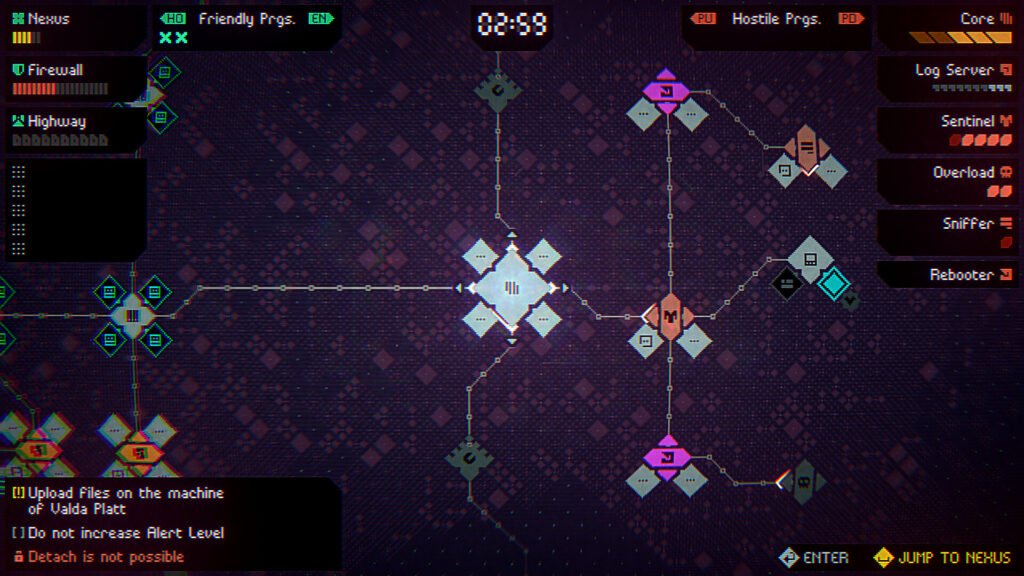MicroProse is one of the true veteran publisher brands in video games today, having originally been established back in 1982, the era of Atari and the Intellivision. While it has gone through various incarnations over the years, the latest iteration was started in 2019, when it was revived by David Lagettie. Since then it has published a variety of fairly small games, mostly in the flight combat and simulation field, as well as some remasters of earlier MicroProse titles. Drop – System Breach is the latest title from indie studio Etherfield Games, and marks the start of the new MicroProse branching out into publishing different genres.
You play as an unnamed rookie hacker who is starting out in a vaguely dystopian and cyberpunk world, taking on missions such as breaking into megacorporations data vaults, lifting sensitive data, and making a tidy profit. Along the way, you attract the attention of hacker collective The Swarm, and things become even more intriguing. Drop – System Breach is a hacking game, but not in the way you might expect. This is less like Introversion’s Uplink or Fractal Alligator’s Hacknet, and more Speed Chess. There is a story and plenty of decent cyberpunk-inspired writing, but it takes a backseat compared to the fast-paced challenge of the gameplay.

The task is simple; get in, find the relevant data or perform the required task, and get out, all within a five minute window. Hacking into a system is as simple as the push of a button; you select your target system, and then hack it. However, the goal in missions is not simply to hack in, but to find specific information on a specific computer. Often, the network will contain dozens of computers and you have no idea which one contains the information you need. This will require jumping between various computer nodes, hacking each one to see if it contains what you need. Different nodes have different purposes; some are just local user computers while others are data stores, or network routers. Hacking these gives you different options, often with multiple routes to the same objective.
Along the way you are bound to trigger the system’s anti-intrusion software. This process regularly attacks your firewall, whittling down its health gradually. Lose it completely, and your nexus will be exposed, which will fail the mission if it’s destroyed. You can help to keep the firewall protected with a repair subroutine, but this means using up one of your precious threads. Threads are how many actions you can perform at the same time; it starts as two, but can be upgraded. For example in an early mission you need to ping a network router five times; you can do this either five times individually, or you can queue up two at a time to run concurrently.
Due to the focus on speed you will be routinely hopping across the network trying to breach multiple systems at once, and the more threads you have, the faster this can be done. Upgrading your CPU speed allows you to perform all hacking actions faster, while later you can purchase various hacking daemons, which will allow some tasks to be performed passively. You’ll also need to monitor the network logs; all actions you take within a system will be logged, and if you accumulate too many it will raise the network security level. You can delete these logs, but again you’ll need to use thread space to do so.

In essence, this need to be swift and precise, hacking into systems, jumping across the network, deleting logs and monitoring your firewall health all combine to create a game which is simple to get the hang of but continually challenging; new levels tend to gradually add newer and harder goals, and more difficult security countermeasures to overcome. At some point accessing some systems will require you to complete a small mini-game such as matching colours or shapes, which provide a minor distraction and use up more of your precious time.
Aesthetically the game somewhat reminds me of a 2D version of the hacking game from Deus Ex: Human Revolution, but a lot more low-fi. It looks like you’re looking at an old-fashioned CRT monitor, with distinctive bloom and pixelated elements. The game has a visual language you will get the hang of pretty quickly, and it always looks stylish, like how you imagine hacking should look like. While it is possible to play the game with a keyboard (the mouse does nothing), a controller is the preferred method as it allows you to hop between systems much faster and more smoothly.
Drop – System Breach is an excellent speed hacker, continually holding you on the edge of chaos as you try to juggle half a dozen different tasks simultaneously. Its simplicity masks its ingenuity of forcing you to constantly be making snap decisions, trying to execute the speediest hack possible, while still chasing after optional mission rewards. The learning curve is gentle but fair, and the story interwoven into the missions is a reasonably involving backdrop to proceedings. Drop – System Breach only has a PC version at the moment but seems ideally suited to get a Nintendo Switch port at some time in the future.





